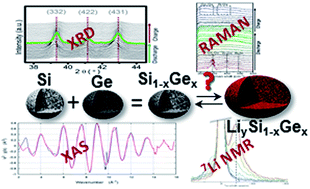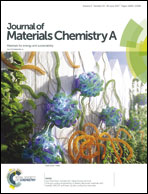Understanding the lithiation/delithiation mechanism of Si1−xGex alloys†
Abstract
GexSi1−x alloys have demonstrated synergetic effects as lithium-ion battery (LIB) anodes, because silicon brings its high lithium storage capacity and germanium its better electronic and Li ion conductivity. Previous studies primarily focused on intricate nanostructured alloys with high costs of production, but here we studied the simpler Si0.5Ge0.5 alloy as a composite electrode. The electrochemical mechanism is explored by a combination of in situ and operando techniques such as powder X-ray diffraction (XRD), X-ray absorption spectroscopy (XAS), Raman spectroscopy and 7Li solid state nuclear magnetic resonance spectroscopy (NMR), all providing unique and complementary information about phase transformations during cycling. In this way amorphization of c-Si0.5Ge0.5 upon lithiation (discharging) and crystallization of a new phase at the end of the discharge have been identified. Additionally, an evolution of the refined cell parameters was observed and related to an overlithiation process. The crystallinity of Si0.5Ge0.5 was not restored upon charging (delithiation) and an amorphous phase was obtained. Lastly, an improved understanding of the electrochemical mechanism of Si1−xGex alloys is mandatory for assessing their viability as LIB anodes.



 Please wait while we load your content...
Please wait while we load your content...